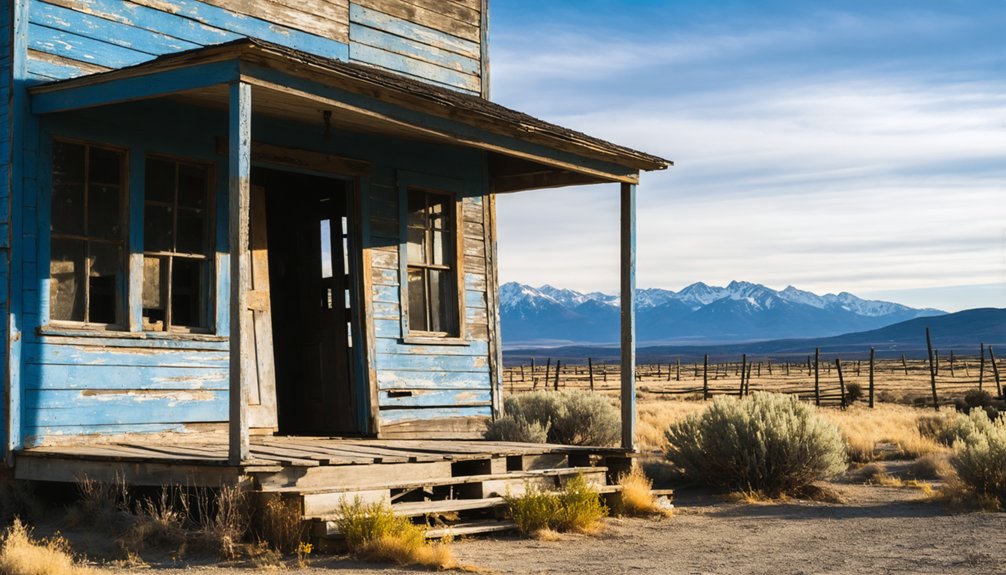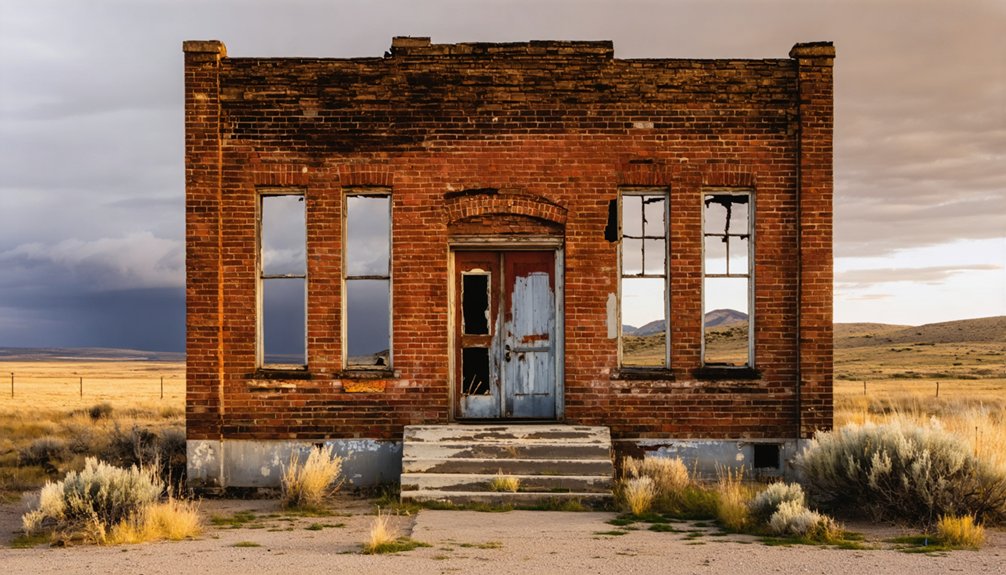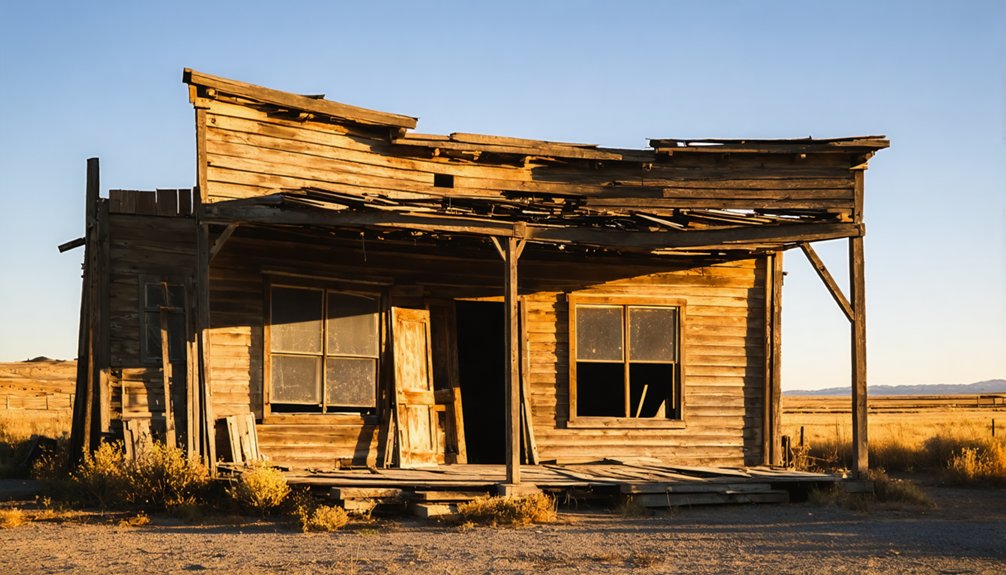You’ll find the ghost town of Ulysses tucked away in Idaho’s Salmon National Forest at 4,902 feet elevation, where gold was discovered in 1901. The settlement’s centerpiece was the thirty-stamp Kittie Burton Mill, processing ore transported via cable tramway from nearby mines. At its peak, the district produced $600,000 in gold before declining by 1912. Today, weathered cabins and mill ruins dot the rugged landscape, telling tales of Idaho’s ambitious mining era.
Key Takeaways
- Ulysses was a mining settlement discovered in 1901 in Idaho’s Salmon National Forest, producing gold, silver, copper, lead, and zinc.
- The town’s prosperity centered around the Kittie Burton Mill, a thirty-stamp facility that processed low-grade ore until economic decline.
- Mining operations yielded approximately $600,000 in gold value before declining due to high operational costs and geographic isolation.
- Today, Ulysses is an abandoned ghost town featuring collapsed structures, old mine shafts, and remnants of the Kittie Burton Mill.
- Visitors must navigate unpaved roads through rugged terrain and should exercise caution due to hazardous structures and lack of infrastructure.
The Birth of a Mining Settlement
When prospectors discovered the Ulysses Mine in 1901, they uncovered a rich deposit of gold, silver, copper, lead, and zinc that would establish one of Idaho’s notable mining settlements.
The 1901 discovery of the Ulysses Mine revealed vast mineral riches that shaped Idaho’s mining legacy for generations to come.
Following the pattern of earlier prospector stories from the Leesburg rush of 1866, fortune seekers ventured into the rugged Salmon River region, drawn by dreams of striking it rich.
You’ll find the settlement emerged in the Indian Creek District of the Salmon National Forest, where miners faced significant settlement challenges at 4,902 feet elevation.
The steep valley terrain and harsh mountain climate tested their resolve, but the proximity to the Salmon River provided essential water access.
Like Nicholia’s lead production that once supplied 25% of America’s lead, Ulysses showed promise as a significant mineral producer.
Kitty Burton Mining Co. took ownership of the operation, developing it into an underground mining venture.
As with nearby Gibbonsville and Shoup, the camp grew as merchants and laborers arrived to support the expanding mining operations.
Mining Operations and Infrastructure
You’ll find that mining operations at the Ulysses site centered around the thirty-stamp Kittie Burton Mill, which processed low-grade ore using a combination of crushing and amalgamation techniques common to early 1900s gold extraction.
To overcome the challenging terrain, the company constructed an innovative cable tramway system that transported ore from the mine workings to the mill site below.
The mill’s equipment included stamp batteries, concentrating tables, and mercury amalgamation plates – all powered by steam engines that required constant fuel supply in the remote location.
Cable Tramway Transport System
The cable tramway system at Ulysses revolutionized mining operations in 1901, connecting the remote Kittie Burton and Ulysses mines directly to the processing mill through rugged mountain terrain.
The cable engineering marvel allowed miners to transport ore continuously without relying on slow, costly manual labor or animal-drawn carts. Like other early systems, it relied on gravity powered operation to maintain momentum once loads were in motion. At the site today, remnants include metal wheel components scattered throughout the wash area.
While exact specifications haven’t survived in records, you’ll find the system likely mirrored other tramways of the American West, featuring extensive towers and cables designed to span steep mountainsides.
This infrastructure investment demonstrated strong confidence in Ulysses’ mineral potential, dramatically lowering per-unit transport costs and enabling the mines to process higher volumes of ore daily.
The tramway’s efficiency helped sustain operations through market fluctuations, though eventually the town would still succumb to the fate of many Western mining communities.
Kittie Burton Mill Operations
Mining operations at Kittie Burton centered around a mighty 30-stamp mill that processed gold and silver ore from 1901 onward.
You’ll find the mill was powered by advanced milling techniques for its time, utilizing water systems and steam engines to crush low-grade ore averaging 0.037 to 0.04 ounces of gold per ton.
During peak seasons, you’d have seen 30 to 90 workers manning the operation, from skilled mill operators to mechanics.
The site bustled with workshops, blacksmith shops, and timber structures for ore storage and worker housing.
The mill’s success relied on efficient water management through flumes and pipes that powered the stamp batteries and sluices.
The facility processed a variety of minerals including galena and sphalerite extracted from the nearby deposits.
A devastating setback occurred when the mill was destroyed by a fire in 1919, causing unemployment for dozens of workers.
Despite periodic setbacks from fires and equipment failures, the mill remained vital to the region’s mineral extraction until the mid-20th century.
Gold Extraction Equipment
While underground veins held Ulysses’ mineral wealth, an intricate network of extraction equipment made accessing these riches possible.
Similar to techniques used in placer mining operations, miners would separate gold from gravel and clay through careful washing processes. You’d find drills cutting through rock, ore carts hauling precious material, and heavy timber supports stabilizing extensive tunnel networks. The mining techniques centered on following gold-bearing quartz veins deep into the mountainside.
The heart of gold extraction lay in the stamp mills, particularly the Kittie Burton Mill, where massive stamps crushed ore to free precious metals. Big rocks frequently caused operational delays by blocking equipment and slowing down the extraction process.
Cable tramways transported the ore from mines across rugged terrain to these processing facilities. It’s a demonstration of mining ingenuity that they developed such thorough systems, including water supply infrastructure for ore processing and roads for equipment transport, all while working in remote mountain conditions.
Daily Life in Historic Ulysees
Living in historic Ulysees demanded remarkable resilience from its inhabitants, who faced harsh winters and isolation amid Idaho’s rugged terrain.
You’d have found your daily routines revolving around the mines, where you’d spend long hours underground using basic tools to extract gold ore.
After your shift, you’d return to simple log cabin housing, where community dynamics centered on survival and mutual support rather than formal social structures.
Without schools, churches, or established businesses, you’d rely on your fellow miners for both work and companionship, much like the close-knit community that thrived in Leesburg.
The cable tramway‘s mechanical rhythm would punctuate your days as it transported ore to the Kittie Burton Mill.
Your supplies would arrive via rough mountain roads, making self-sufficiency essential in this remote mining settlement.
Activities peaked during summer months, as the milder weather made mining operations and daily life more manageable.
The Golden Years: Peak Mining Era
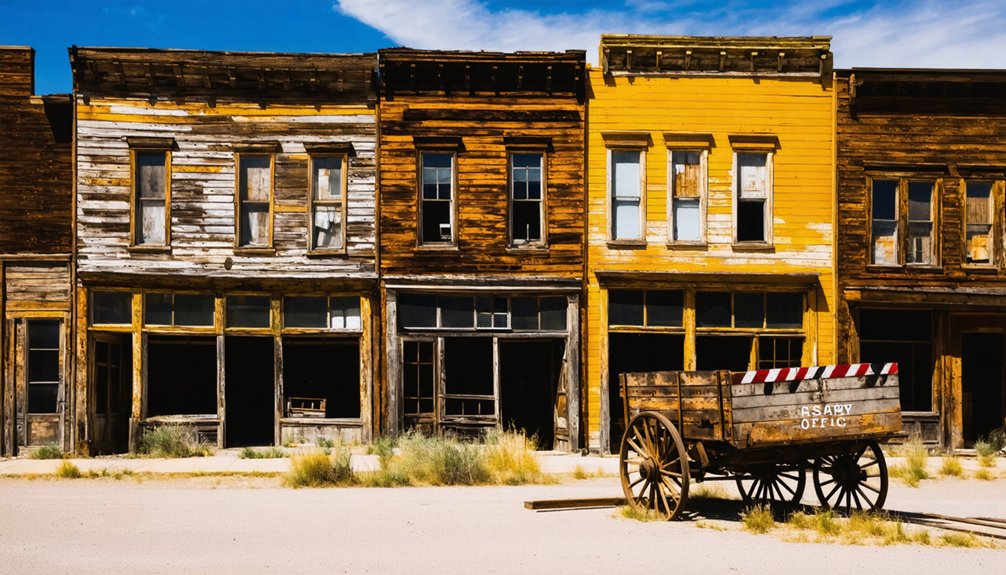
During the peak years of 1902-1904, you’d find Ulysses thriving with its thirty-stamp mill processing $10/ton ore and cable tramways efficiently moving materials across the rugged terrain.
You could see outside investors pouring capital into the Kittie Burton Mining Company‘s operations, enabling the rapid expansion of milling capacity and infrastructure development throughout the Indian Creek District.
Your investment in Ulysses mining would’ve seemed promising until September 1904, when a devastating fire destroyed Idaho’s largest gold mine, marking the beginning of the end for profitable operations in the area.
Mill Operations and Transport
As mining activity intensified in Ulysees around 1901, the Kittie Burton Mill emerged as the district’s central ore processing facility. Stockholders financed its construction to tackle significant transport challenges in the remote mountainous terrain.
To solve the uphill ore movement problem, they installed innovative cable tramways linking both the Ulysees and Kittie Burton mines directly to the mill.
You’ll find that mill innovations helped the district achieve substantial production, yielding approximately $600,000 in gold value during peak operations.
However, by 1912, the mill’s profitability declined due to low-grade ore and high operational costs. Despite the advantage of onsite processing that minimized expensive smelter shipments, water shortages and ore quality issues eventually led to the mill’s closure, leaving only ruins and scattered cabins as evidence of this ambitious mining venture.
Rich Claims and Financing
The promise of rich mineral deposits drew ambitious miners to file the first claims in Ulysses around 1895, though significant mining wouldn’t begin until 1901.
You’ll find the earliest claims centered on gold and silver, with the Kittie Burton and Ulysses mines leading development in this promising district near Indian Creek.
Investment strategies relied heavily on stockholder financing to build critical infrastructure, including the Kittie Burton Mill and cable tramways for ore transport.
The claims expanded to roughly 100 unpatented lode mining claims covering 809 hectares.
Financing sources targeted not just precious metals but also the area’s rich potential for copper, lead, and zinc.
The region’s complex geology, marked by the White Ledge Shear and numerous faults, continued attracting investors well into the mid-20th century.
Natural Surroundings and Geography
Nestled within Lemhi County’s rugged terrain, Ulysses sits upstream from the Salmon River road near Indian Creek at an elevation 1,200 feet above its original townsite.
Perched high in Lemhi County’s wilderness, Ulysses overlooks its historic foundations near Indian Creek, 1,200 feet below.
The remote wilderness surrounding the ghost town features steep slopes, narrow valleys, and scattered remnants of mining operations that dot the landscape.
You’ll find the area dominated by coniferous forests and montane vegetation typical of central Idaho’s interior mountains.
The site’s geology, shaped by complex mineralization and gold-bearing deposits, attracted early prospectors to this challenging environment.
Indian Creek’s waters once supported both placer and hydraulic mining operations, though today only seasonal streams remain active.
While 2WD vehicles can access the site via dirt roads during dry conditions, you’ll need to plan carefully – the rugged terrain offers minimal services and no modern amenities.
Economic Rise and Decline
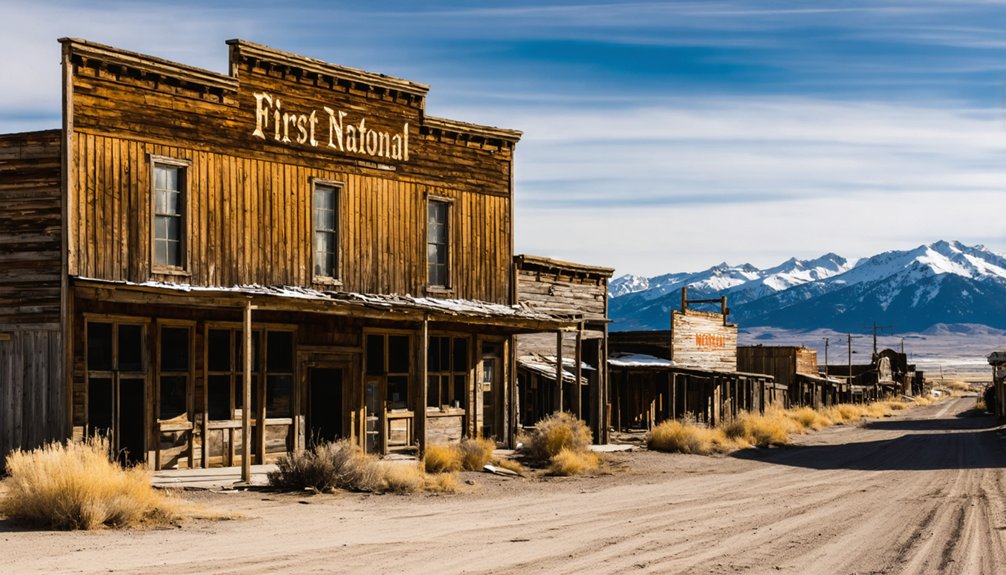
Mining fever struck Ulysses in 1895 when prospectors filed their first claims, though significant operations wouldn’t begin until 1901.
The arrival of a stamp mill in 1902 launched the town’s golden age, with the Kittie Burton Mill processing ore transported via cable tramways from nearby mines. You’ll find that by 1912, the district had produced about $600,000 in gold.
Economic shifts proved challenging as operational costs soared and ore quality diminished.
Mining challenges included geographic isolation and expensive shipping costs that ate into profits. The stockholder-financed operations couldn’t sustain profitability as veins depleted, leading to the closure of mills and eventual abandonment of the town.
Without alternative industries to fall back on, Ulysses followed the fate of many Idaho mining towns, transforming from a bustling settlement into a ghost town.
Exploring the Ghost Town Today
Today, intrepid explorers who venture to Ulysses will find a challenging but rewarding journey into Idaho’s mining heritage.
You’ll need to navigate unpaved roads through rugged terrain to reach this remote site in Lemhi County, where the collapsed Kittie Burton Mill and a few weathered cabins stand as silent witnesses to the past.
You’ll want to come prepared – there’s no infrastructure, cell service is spotty, and the nearest help is far away.
While ghostly encounters with the past await in the scattered ruins, you’ll need to watch for hazards like unstable structures and old mine shafts.
The mountainous, forested landscape offers glimpses of both natural beauty and mining’s environmental impact.
Remember to bring water, food, maps, and a reliable vehicle, and always practice Leave No Trace principles.
Preserved Remnants and Structures
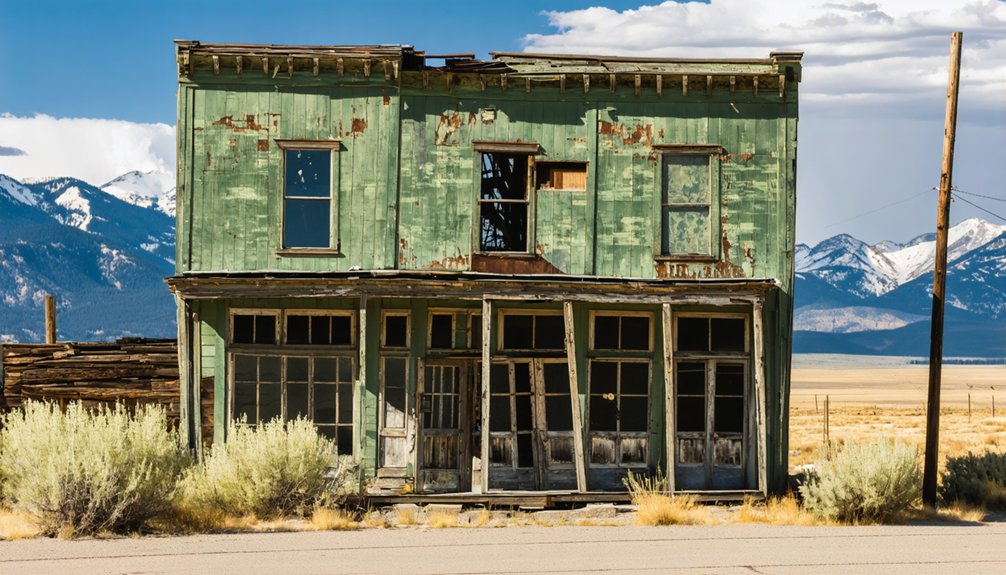
The weathered bones of Ulysses’ once-bustling mining community now stand as deteriorating remnants scattered across the Idaho landscape.
You’ll find the collapsed ruins of the Kittie Burton Mill, once the town’s economic powerhouse, now reduced to weathered lumber. A few original mining cabins still dot the terrain, though they’re steadily succumbing to time and elements.
The abandoned structures tell a story of quick prosperity and decline. While the region’s dry climate has helped preserve some wooden remains, you won’t find many historical artifacts on-site.
The cable tramways that once transported ore have vanished completely, and only scattered foundations mark where other buildings stood. Compared to other Idaho ghost towns, Ulysses retains minimal intact structures, making it a raw representation of the transient nature of mining boom towns.
Legacy of Idaho’s Mining Heritage
While the physical remains of Ulysses fade into the landscape, Idaho’s broader mining legacy tells a remarkable economic story. From 1860 to 1969, the state’s mineral production reached $3.42 billion, with metals accounting for $2.88 billion of that wealth.
Idaho’s mining ventures yielded billions in mineral wealth, transforming the landscape and economy during a century of intensive extraction.
You’ll find this mining impact particularly evident in places like Shoshone County, which dominated the state’s silver, copper, lead, and zinc production for half a century.
Today, you’re witnessing a complex legacy that balances economic prosperity with environmental challenges. The EPA reports that 40% of Western watersheds face mining contamination, while organizations like the Idaho Conservation League work to protect the state’s natural resources.
Despite these concerns, Idaho’s mining heritage continues through modern operations, including phosphate production that supplies nearly a quarter of the nation’s needs.
Frequently Asked Questions
Are There Any Reported Ghost Sightings or Paranormal Activity in Ulysees?
You won’t find documented ghost encounters or paranormal investigations in Ulysees – it’s a town where the only spirits that vanished were the miners who left when the gold ran dry.
What Happened to the Original Residents After the Town Was Abandoned?
You’ll find most residents’ fate led them to nearby mining towns like Custer, while others turned to ranching in Lemhi County. Some moved west seeking new opportunities, leaving behind their town’s legacy.
Was There Ever a Post Office or School in Ulysees?
Like a fleeting shadow in history, you won’t find records of either a post office or school in Ulysees’s community. These services were likely shared with nearby established towns during its mining days.
Did Any Famous Outlaws or Notable Historical Figures Visit Ulysees?
You won’t find any outlaw legends or historical visitors tied to Ulysees. Records show the town was purely a corporate mining venture, with no documented visits from famous outlaws or notable figures.
How Much Gold Was Extracted From Ulysees Mines During Its Operation?
Like a treasure shrouded in mystery, you’ll find no exact records of gold extraction from these mines. Mining techniques of the early 1900s yielded small-scale production, likely under 5,000 ounces total.
References
- https://pinintheatlas.com/travel-blogs/ghost-towns-of-idaho/
- https://history.idaho.gov/wp-content/uploads/2018/08/0064.pdf
- https://hicksfamilyhistory.com/?query-0-page=2
- https://lemhi.idgenweb.org/places.html
- https://www.ghosttowns.com/states/id/ulysees.html
- https://1043wowcountry.com/10-idaho-ghost-towns/
- https://history.idaho.gov/wp-content/uploads/2018/08/0009.pdf
- https://westernmininghistory.com/mine-detail/10105760/
- https://history.idaho.gov/wp-content/uploads/0242.pdf
- https://pubs.usgs.gov/bul/0528/report.pdf
